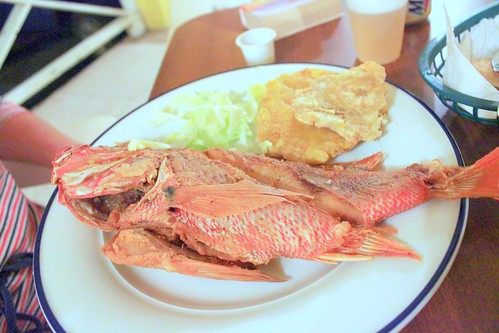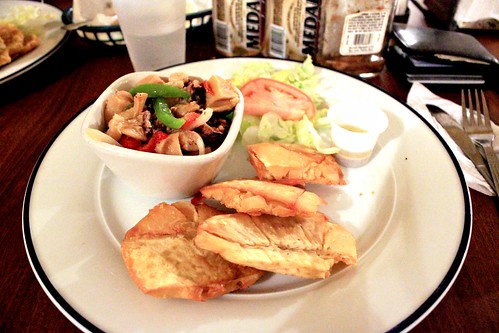Conventional wisdom dictates that one should never eat at an empty restaurant, especially early in the week, but if there is absolutely nowhere else open and you have no choice, do yourself a favor and avoid the seafood. Happily, Vieques, a 55-square mile island off the east end of Puerto Rico, and former bombing range of the US Navy, if it doesn’t exactly flaunt convention, certainly defies it. And Tito Bloque, the only restaurant off the malecon in the village of Esperanza, and therefore the only empty restaurant, personifies that defiance.
Blazing overhead strip lights do nothing to obscure the restaurant’s complete absence of customers. In fact, when the only visible human forms in the place are a signed photo of Charles Bronson in his Death Wish era and an old man dozing in a hammock fashioned from a Puerto Rican flag, the feeling of unwelcomeness is only accentuated.
Undeterred, we enter. Geckos dart up the walls and the noise of our flip-flops on the tiled floor rouses the somnolent geezer. Stirring, he opens one eye. Trying our best to look casual and friendly, we ask if they’re open, offering a cheerful “Hola, buenas tardes!” “Claro que si, jovenes.” (Yes, clearly, folks.) comes the affirmative reply, stating a fact that seemed far from obvious to us.
He gestures vaguely to our left mumbling the word “menu”, and we wander over to a counter in front of the empty kitchen. Staring helplessly for a few long moments at a shelf of half empty rum bottles and a refrigerator decorated sparsely with cans of Medalla beer, we look back to our right and notice that the man has once again been overtaken by his slumbers. Shrugging at one another, we are about to turn on our heels when a spritely woman in her mid-sixties appears before us, eyebrows raised in impatience. “Hola” we repeat, and, even more gingerly, inquire about provisions she may have. “¿Cuál hay comer esta noche?(What is there to eat tonight?) “Siempre lo mismo” (Same as usual.) she replies, brandishing a pair of tired-looking menus.
Feeling somehow compelled to stay and eat after having so obviously disturbed this elderly couple’s quiet evening, we ask her to pick something for us.* She tells us that she’ll make the conch salad and whole fried fish, to which her shut-eyed husband – finger wagging in the air for emphasis – recommends she add some octopus because he prefers the salad as a mixture of seafood. After making a face at him as if to say “Octopus?! These are Americans, you know!”, she looks at us and asks, somewhat testily, if we eat octopus. When we confirm that we do she is sufficiently mollified that our requests for side orders of plantain and breadfruit tostones elicit no debate. Then, on our way across the dining room to our chosen table, the recumbent gent offers us a go on his bug spray. “Are they bad tonight?”, I ask. “It depends.” He replies enigmatically.
Sitting in the empty restaurant, clutching cans of beer, smelling strongly of deet and feeling somewhat strange about the whole thing, I endeavor to break the ice and ask our weary friend what the Spanish word is for geckos. Seemingly impressed that I know the Spanish word for lizard (lagarto), he comes over and slouches at our table, baring his bumpy old man’s chest through an open shirt, and asks us where we’re from. As we explain, his wife brings over a basket of still-hot homemade arepas with garlic butter. She congratulates me on my primitive Spanish, and asks if I’m Puerto Rican. Incredulous, given my pale, Northern-European looks, I deny it and fear that our cook may be blind. When she explains that she asked this because so few visitors try to speak Spanish in Puerto Rico that she figured we must be somehow different from regular Americanos, we suddenly feel rather pleased and more comfortable with our surroundings.
Slathering our arepas with pungent butter, we proceed to question her husband, elbows still on our table, about Vieques and Esperanza. We learn that he’s originally from Fajardo, on the east end of Puerto Rico but moved here forty years ago. Warming to his theme, and mistaking my ability to speak the language with aural comprehension, he begins speaking at an unfeasible velocity before taking me over to a framed newspaper article on the wall next to Charlie Bronson, and encouraging me to read what’s there about the history of Vieques and his restaurant.
Studying it, the limitations of my reading comprehension are also laid bare and though I manage to translate the phrase “Sin Tito Bloque, no habria un Vieques” (without Tito Bloque, there would be no Vieques), all I manage to deduce is that the restaurant was named for a local notable who faced off against the American Navy in advocating for the island’s return to its Viequense residents. I am pleased to return to the table to find nothing more intellectually challenging than generous servings of warm conch and octopus salad and giant rounds of breadfruit awaiting me. Amy’s fish is equally sized, a spanking fresh red snapper (chillo) scaled but not finned, deep-fried with the minimum of flour and perfectly seasoned. Also on the table is a bottle, formerly home to a fifth of Palo Viejo rum, now an inch deep in a venomous-looking homemade salsa picante. Nodding at it, our hostess makes a pained face and cautions us to use it sparingly.
The old man retires to his hammock once more and we are left to enjoy our dinner, which is phenomenal. As authentically Puerto Rican a meal as we will find during our trip. Later on, after she has brought me a complimentary second-helping of conch salad, he returns and explains that breadfruit, like plantains, are eaten both green and ripe, as a starchy side-dish and to make sweet desserts, respectively. More questions follow about tropical fruits and how they’re grown locally, and his wife rejoins us to tell us that all the vegetables in the sofrito base for the salad in were grown out back, and that her husband raises the chickens, guinea hens and land crabs featured on the menu. Fascinated by the concept of farming crabs, our interest prompts an invitation to return the next day for lunch so they can show us their operation.
Evidently feeling certain by this point we are in fact a different type of Americano visitor, they begin to describe a series of run-ins with the Yankee tourists to whom their next-door neighbor recently rented his house over their complaints about the crowing rooster and the barking of their dogs, and how it was ruining their vacation. Clearly still incensed by this, they warn us, presumably on behalf of all American tourists, that if all we want to do is sit on a beach reading a book and enjoy the same conveniences as at home then we shouldn’t visit Vieques. Point already made, they seek to drill it home, rather unnecessarily given the restaurant’s appearance, saying, that if they really wanted Americans to eat at Tito Bloque they would be “f—king us with table cloths and new menus”.
As we prepare to leave, full and reeling somewhat from all we’ve seen and heard, we finally introduce ourselves and learn that her name is Isabel, but that she’s known universally as Puche, and that our sleepy host was none other than Tito Bloque himself. Suddenly, everything fits into place, and we exit the restaurant past a wooden machete painted like the Puerto Rican flag emblazoned with the slogan “Defiende tu Cultura!” (Defend your culture!).
Calle Acacia, Esperanza
Vieques, Puerto Rico
* We didn’t actually disturb their quiet evening at all. Apparently, being the only customers of the evening is almost customary at Tito Bloque. The unusual aspect of our visit was that they ended up being moderately welcoming. More often that not, they’ll simply playfully mock you to your face.




Great story — and story telling ability! I felt like I was there. -k
Great tale…I hope you’ve got more from your trip.
Great story! I felt like I was there, too! It seems like a very unusual place, yet I wanna visit it.
Thanks for sharing your adventure. Nice to be back in Puerto Rico again.
LL
Ohla! we just got back from a Company sponsored 5 day trip to PR–from Hawaii–18 hrs, L.A. then Miami, then San Juan– but worth every minute–we rarely got to leave the resort, only one day in Old SJ, but the purpose was more business than pleasure—even so, the resort did a remarkable job with the 3 meals a day for 500 people from all over the USA –no complaints–expect unable to visit your hammock-guy’s–next time! Returning to HI we stopped to see friends in Staten Island and MORE than made up for home-cooked and deli Italian–we brought 30 lbs of cold cuts back to HI—this is too long, sorry—ciao!
P.s. per your recommendation, In flight to PR (remember—18 hour-trip! read L.Durrell’s Bitter Lemons; A time to Keep Silence; Just started his Justine (and will of course HAVE to get the other 4) and on the return flt (ONLY 12 hrs–non stop) started to read Kate Christenson,s Epicure’s Lament which I highly rec and her eponymous (ohh, that word) blog—-thank you— I love Durrell!~
@Deb: so glad you enjoyed “Bitter Lemons”. It really is a lovely piece of work and it’s nice to learn through it that he and Patrick Leigh Fermor were friends. I didn’t realize Kate Christenson was published but I’ve checked out her blog and agree shes a fine writer, someone to aspire to emulate. Someone else, that is.
Oh, heck yes, forgot to mention Fermor as author –and friends!! w/ DL….I replyed to Kate and suggested she ck youz out.. (one week in NY and I’m youz’n all over! ha –helps that my morito is a-la-Bronx–36 yrs ago—same accent which of course he denies…I’d KILL for an accent)
Also just finished Kurlansky’s Basque book and started Food of a Younger Age (?)…gotta admit I skip some techie, but very very good
Aloha!
Fantastic story. Thoroughly enjoyed reading it!
We’re going to be staying at the pink house next door. This will be our 4th trip to VQS and we’re really looking forward to meeting Isabel and Tito! I hope they’re nice to us!
@Vanessa: we are unbelievably jealous. Almost sick with envy, in fact. Please come back and let us know how it/they was/were! Our dinner there was an unforgettable experience.